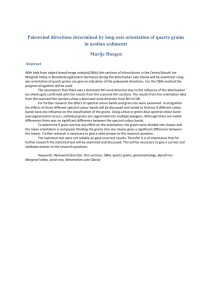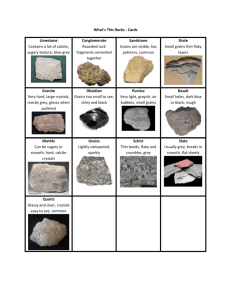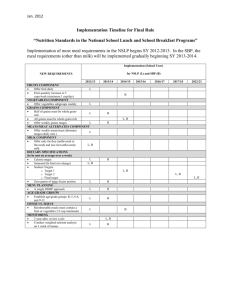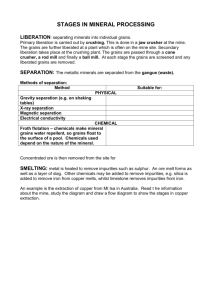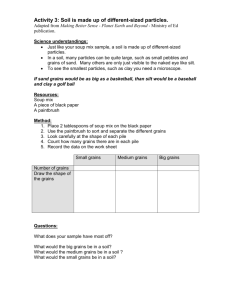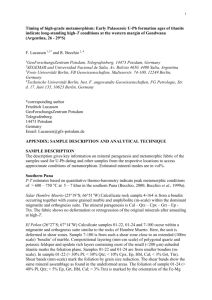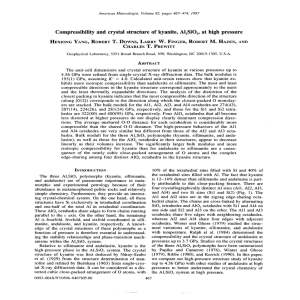Lab 06
advertisement
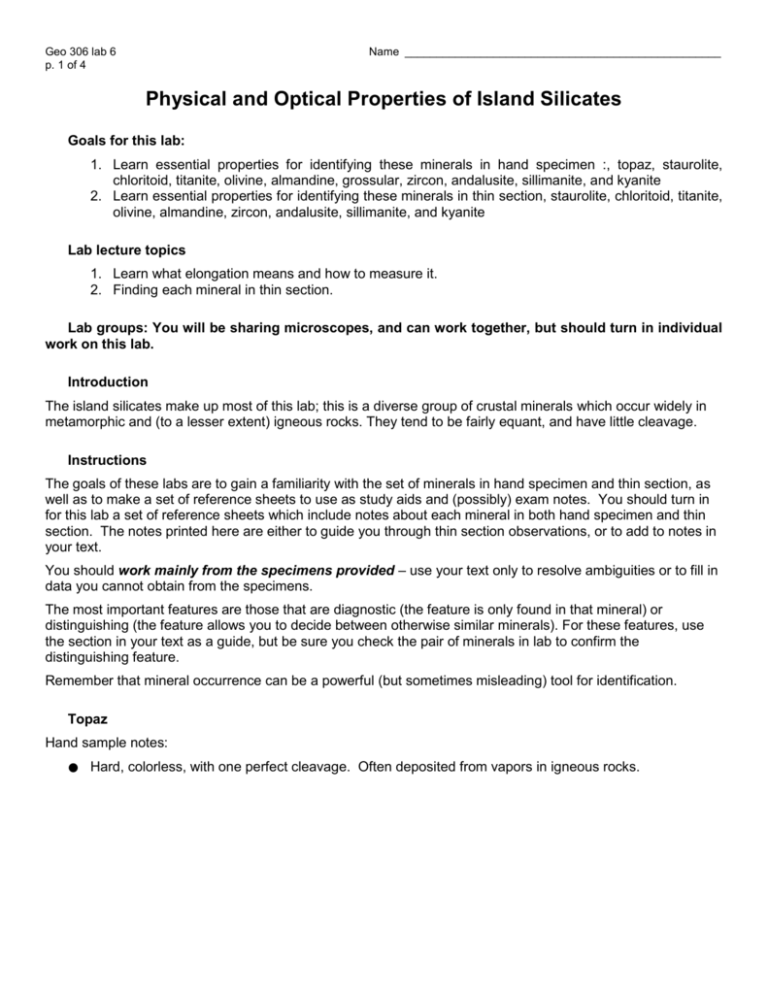
Geo 306 lab 6 p. 1 of 4 Name __________________________________________________ Physical and Optical Properties of Island Silicates Goals for this lab: 1. Learn essential properties for identifying these minerals in hand specimen :, topaz, staurolite, chloritoid, titanite, olivine, almandine, grossular, zircon, andalusite, sillimanite, and kyanite 2. Learn essential properties for identifying these minerals in thin section, staurolite, chloritoid, titanite, olivine, almandine, zircon, andalusite, sillimanite, and kyanite Lab lecture topics 1. Learn what elongation means and how to measure it. 2. Finding each mineral in thin section. Lab groups: You will be sharing microscopes, and can work together, but should turn in individual work on this lab. Introduction The island silicates make up most of this lab; this is a diverse group of crustal minerals which occur widely in metamorphic and (to a lesser extent) igneous rocks. They tend to be fairly equant, and have little cleavage. Instructions The goals of these labs are to gain a familiarity with the set of minerals in hand specimen and thin section, as well as to make a set of reference sheets to use as study aids and (possibly) exam notes. You should turn in for this lab a set of reference sheets which include notes about each mineral in both hand specimen and thin section. The notes printed here are either to guide you through thin section observations, or to add to notes in your text. You should work mainly from the specimens provided – use your text only to resolve ambiguities or to fill in data you cannot obtain from the specimens. The most important features are those that are diagnostic (the feature is only found in that mineral) or distinguishing (the feature allows you to decide between otherwise similar minerals). For these features, use the section in your text as a guide, but be sure you check the pair of minerals in lab to confirm the distinguishing feature. Remember that mineral occurrence can be a powerful (but sometimes misleading) tool for identification. Topaz Hand sample notes: Hard, colorless, with one perfect cleavage. Often deposited from vapors in igneous rocks. Geo 306 lab 6 p. 2 of 4 Staurolite Hand sample notes: Euhedral crystals are common; grain shapes are distinctive. Twinning, though common, is not always present. Thin section notes: Yellow pleochroism is distinctive; it is more pronounced with higher Fe content. Inclusions are very common. MBr38 has sparse crystals with a distinct yellow color and weak pleochroism. Note the crystallographically controlled distribution of inclusions. PM026A also has large staurolite grains with many inclusions. Chloritoid Hand sample notes: Small elongate prisms are common. Only found in pelitic (Al-rich) metamorphic rocks. Thin section notes: Blue pleochroism together with low first-order colors are distictive. May show polysynthetic twinning, MBr6 has very large chloritoid porphyroblasts that dominate the rock. Titanite Note: this mineral used to be called “sphene”. That name is no longer accepted. Hand sample notes: Rarely seen in hand specimen. Common accessory mineral in granitoids, and very common in metamorphosed limestones. Thin section notes: Extreme birefringence together with extreme relief and brown color combine to make titanite look the same in PP as it does in XP (when not at extinction). Wedge-shaped crystals are diagnostic. SN14 has quite a few titanite grains that show the distinctive wedge shape. SS021B has a number of more anhedral titanite grains. Geo 306 lab 6 p. 3 of 4 Olivine Hand sample notes: Lacks cleavage; pale green color, typically. Generally anhedral and equant. Found mainly in ultramafic igneous rocks. Thin section notes: Often altered to yellow isotropic iddingsite along fractures. Many of the phenocrysts in Tillamook (Burn) are olivine, probably closer to the forsterite end-member than fayalite. IPu37 is dominated by large round grains of olivine, with other minerals growing in the interstices. Almandine Hand sample notes: Very commonly euhedral, forming diagnostic dodecahedral shapes (with rhombic faces). Conchoidal fracture; deep red color. Typically found in metamorphic rocks, although can occur in some Al-rich igneous rocks also. Thin section notes: Isometric, so black in XP. Pale pink in PP, often with inclusions. Very often euhedral. MBr38 and PM026A both have euhedral garnet crystals that are probably rich in Fe (making them pyralspites). Grossular Hand sample notes: Lacks cleavage; pale green color, typically. Typically light green color, sometimes showing growth “rings” (zoning). Found mainly in skarns or metamorphosed marls. Zircon Hand sample notes: Rarely found as coarse crystals, but tetragonal shape is distinctive along with brown color. Thin section notes: Forms pleochroic haloes in enclosing biotites or cordierites. Very high relief and strong second-order colors. SN14 has sparse, tiny grains of zircon, which may be hard to spot. Look for tiny high-relief grains that show bright colors in XP. MBr42 also has very tiny grains, but they often produce pleochroic halos in the biotites, which makes them easy to find. Geo 306 lab 6 p. 4 of 4 Andalusite Hand sample notes: Chiastolite cross is diagnostic, if present. Often forms elongate prisms with roughly square cross-sections. Thin section notes: Shows plagioclase-type interference colors, but has higher relief. Often inclusion-rich. Length-fast with parallel extinction. I-S-21 has a fair amount of andalusite, as does MBr6. Look for equant to stubby columnar crystals with inclusions and moderate relief. Kyanite Hand sample notes: Blue colors are common, but may be quite pale. Bladed grain shape. Varying hardness in different directions (but do not scratch up the nice-looking specimens!) Thin section notes: High relief, colorless Inclined extinction (although angle may be small). Length-slow MBr38 has large kyanite porphyroblasts. Be sure to look for the pale blue color in hand specimen. Note that some orientations will have essentially parallel extinction, but others will have inclined extinction. Sillimanite Hand sample notes: Can occur as either prismatic grains or fibrous grains (“fibrolitic sillimanite”, or “fibrolite, but the latter term is deprecated). Often difficult to see if fibrolitic: looks like wispy dirt in the rock. Thin section notes: Cleavage is distinctive in basal section: parallel to long axis of diagonal cut. Note that fibrolitic grains will not show correct interference color because they do not fill the section; they are not 30 µm across. Parallel extinction; length-slow. I-S-21 shows the typical development of fibrolitic sillimanite: little sprays of colorless, high-relief grains that are too thin to affect the interference color of the grains underneath them. MBr42 has lots of coarse, prismatic sillimanite. Note that some of this sillimanite is radiating sprays of acicular grains, but in other cases, it’s confined to an equant outline. This is a pseudomorph, where what was previously a kyanite grain has reacted and turned into sillimanite.

